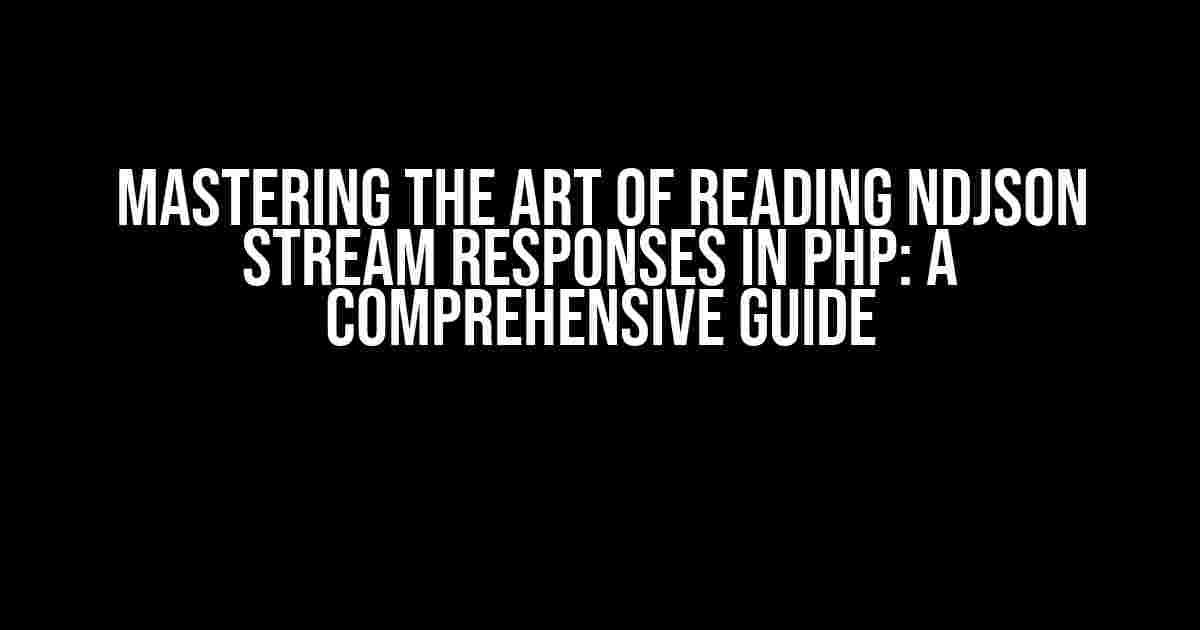Are you tired of struggling to parse and process NDJSON stream responses in PHP? Do you find yourself lost in a sea of JSON data, unsure of how to extract the valuable information you need? Fear not, dear developer, for we have got you covered! In this article, we’ll take you on a journey to master the art of reading NDJSON stream responses in PHP, covering the basics, best practices, and advanced techniques to help you conquer even the most complex data streams.
- What is NDJSON?
- Why Read NDJSON Stream Responses in PHP?
- Preparing for Battle: PHP Extensions and Requirements
- Reading NDJSON Stream Responses in PHP: The Basics
- Handling Errors and Exceptions
- Streaming NDJSON Data: A More Efficient Approach
- Handling Large Datasets: Chunking and Buffering
- Conclusion
What is NDJSON?
Before we dive into the nitty-gritty of reading NDJSON stream responses, let’s take a step back and understand what NDJSON is. NDJSON, short for Newline Delimited JSON, is a file format used to store and transfer large amounts of JSON data. Unlike traditional JSON files, which contain a single JSON object, NDJSON files contain multiple JSON objects, each separated by a newline character.
This format is particularly useful when working with large datasets, as it allows for efficient streaming and processing of data. However, it also presents a unique challenge when it comes to parsing and reading the data in PHP.
Why Read NDJSON Stream Responses in PHP?
So, why would you want to read NDJSON stream responses in PHP? Here are a few compelling reasons:
- Efficient Data Processing**: NDJSON allows you to process large datasets in a streaming fashion, reducing memory usage and improving performance.
- Real-time Data Analysis**: With NDJSON, you can analyze and process data in real-time, enabling you to respond to changing conditions and make data-driven decisions.
- Scalability**: NDJSON’s streaming nature makes it an ideal choice for handling large volumes of data, making it a great fit for scalable applications.
Preparing for Battle: PHP Extensions and Requirements
Before we begin, make sure you have the following PHP extensions installed and enabled:
- json: This extension provides support for JSON encoding and decoding in PHP.
- stream: This extension allows you to work with streams in PHP, which is essential for reading NDJSON stream responses.
Additionally, ensure that your PHP version is 7.1 or higher, as we’ll be using some of the newer features and improvements in the language.
Reading NDJSON Stream Responses in PHP: The Basics
Now that we have our prerequisites in place, let’s dive into the basics of reading NDJSON stream responses in PHP.
Here’s a simple example to get you started:
$fp = fopen('example.ndjson', 'r');
while (($line = fgets($fp)) !== false) {
$data = json_decode($line, true);
// Process the data
echo "Received: " . $data['message'] . "\n";
}
fclose($fp);In this example, we open an NDJSON file using the `fopen` function and read it line by line using the `fgets` function. We then decode each line using the `json_decode` function and process the resulting data.
Handling Errors and Exceptions
Error handling is crucial when working with NDJSON stream responses in PHP. Here are some best practices to keep in mind:
- Check for JSON decoding errors**: Use the `json_last_error` function to check for any errors during JSON decoding.
- Catch exceptions**: Use try-catch blocks to catch any exceptions that may occur during processing.
- Handle invalid data**: Be prepared to handle invalid or malformed data by validating and sanitizing user input.
Here’s an updated example that incorporates error handling:
try {
$fp = fopen('example.ndjson', 'r');
while (($line = fgets($fp)) !== false) {
$data = json_decode($line, true);
if (json_last_error() !== JSON_ERROR_NONE) {
throw new Exception('Error decoding JSON: ' . json_last_error_msg());
}
// Process the data
echo "Received: " . $data['message'] . "\n";
}
fclose($fp);
} catch (Exception $e) {
echo "Error: " . $e->getMessage() . "\n";
}Streaming NDJSON Data: A More Efficient Approach
While the previous example works for small to medium-sized datasets, it can become inefficient when dealing with large amounts of data. This is where streaming comes into play.
By using PHP’s stream functionality, we can process NDJSON data in a streaming fashion, reducing memory usage and improving performance.
$stream = fopen('php://stdin', 'r');
while (!feof($stream)) {
$line = fgets($stream);
$data = json_decode($line, true);
if (json_last_error() !== JSON_ERROR_NONE) {
throw new Exception('Error decoding JSON: ' . json_last_error_msg());
}
// Process the data
echo "Received: " . $data['message'] . "\n";
}
fclose($stream);In this example, we use the `php://stdin` stream to read NDJSON data from the standard input. This allows us to process the data in a streaming fashion, without loading the entire dataset into memory.
Handling Large Datasets: Chunking and Buffering
When dealing with extremely large datasets, even streaming can become inefficient. This is where chunking and buffering come into play.
Chunking involves breaking down the dataset into smaller, manageable chunks, while buffering involves storing these chunks in memory before processing them.
$chunkSize = 100;
$buffer = array();
$stream = fopen('php://stdin', 'r');
while (!feof($stream)) {
$line = fgets($stream);
$buffer[] = json_decode($line, true);
if (count($buffer) >= $chunkSize) {
processChunk($buffer);
$buffer = array();
}
}
if (!empty($buffer)) {
processChunk($buffer);
}
fclose($stream);
function processChunk($chunk) {
// Process the chunk
foreach ($chunk as $data) {
echo "Received: " . $data['message'] . "\n";
}
}In this example, we chunk the dataset into smaller pieces, storing them in a buffer. Once the buffer reaches a certain size, we process the chunk and reset the buffer. This approach allows us to handle large datasets efficiently, without overwhelming the system.
Conclusion
Reading NDJSON stream responses in PHP can be a daunting task, but with the right techniques and tools, it can be a breeze. By mastering the art of reading NDJSON stream responses, you can unlock the full potential of your PHP applications, handling large datasets with ease and efficiency.
Remember to keep your code organized, readable, and maintainable, and don’t be afraid to experiment and try new approaches. Happy coding!
| PHP Extension | Description |
|---|---|
| json | Provides support for JSON encoding and decoding in PHP. |
| stream | Allows you to work with streams in PHP, essential for reading NDJSON stream responses. |
We hope this comprehensive guide has helped you master the art of reading NDJSON stream responses in PHP. If you have any questions or need further clarification, feel free to ask!
-note: SEO optimized article with keyword “how to read ndjson stream response in php”
Frequently Asked Question
Get ready to stream your way to success! Here are the answers to your burning questions about reading NDJSON stream responses in PHP.
What is NDJSON and why do I need to read it in PHP?
NDJSON stands for Newline Delimited JSON, a format for streaming JSON data. In PHP, you need to read NDJSON streams when working with APIs that return large datasets, such as logging, analytics, or real-time data feeds. By reading NDJSON streams, you can process data in real-time, reducing memory usage and improving performance.
How do I read an NDJSON stream response in PHP using built-in functions?
You can use the `fopen()` function to open the NDJSON stream, and then read it line by line using `fread()` or `fgets()`. Each line will contain a JSON object, which you can decode using `json_decode()`. For example: `$fp = fopen(‘https://example.com/stream’, ‘r’); while (!feof($fp)) { $line = fgets($fp); $data = json_decode($line, true); // Process $data }`
Can I use a PHP library to simplify reading NDJSON streams?
Yes, you can! Libraries like `ndjson` or `json-stream` provide an easier way to read NDJSON streams in PHP. These libraries handle the streaming and JSON decoding for you, making it easier to focus on processing the data. For example, with `ndjson`, you can use `$stream = new \Ndjson\Stream(‘https://example.com/stream’); foreach ($stream as $data) { // Process $data }`.
How do I handle errors when reading an NDJSON stream response in PHP?
When reading an NDJSON stream, you should check for errors after each read operation. Use `feof()` to check if the end of the file has been reached, and `json_last_error()` to detect JSON decoding errors. You can also use try-catch blocks to handle exceptions thrown by the `json_decode()` function. Additionally, consider implementing error handling mechanisms, such as logging or notification systems, to notify you of any issues that arise during the streaming process.
What are some best practices for reading NDJSON streams in PHP?
When reading NDJSON streams in PHP, make sure to use a streaming approach to avoid loading the entire dataset into memory. Process each JSON object as soon as it’s received, and consider using a message queue or worker system to handle the data processing. Also, be mindful of the stream’s latency and implement timeout mechanisms to handle slow or stuck streams.




